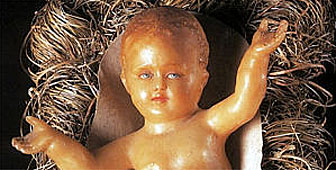Museum charts evolution of the Nativity

A collection of old nativity scenes - from the 18th, 19th and early 20th centuries - is on display until January 21 at the Sensler museum in the town of Tafers in canton Fribourg.
The models come from nearby monasteries, and from across the Alps. Most are made of wax, and even though the technique went out of fashion long ago, the tools of the trade are on display and visitors can watch craftsmen at work casting the Virgin Mary, newborn Jesus and other figures.
Nativity scenes date back to the 4th century when they were carved on Early Christian Roman sarcophagi. They became an essential part of Christian art from the 5th century onwards, and helped to establish the belief that the Virgin Mary was the Mother of God.
The scene has undergone numerous transformations over the centuries and the western European version differs widely from the traditional Middle Eastern interpretation.
The Sensler museum is located in an 18th century schoolhouse in the quaint centre of Tafers. On permanent display is painted furniture typical of the Sense region in the 18th and 19th centuries and examples of local folk costumes.
The museum also showcases handicrafts made with flax and straw. It was once an important cottage industry in the region, which has seen a revival in the handicraft.
swissinfo

In compliance with the JTI standards
More: SWI swissinfo.ch certified by the Journalism Trust Initiative
You can find an overview of ongoing debates with our journalists here. Please join us!
If you want to start a conversation about a topic raised in this article or want to report factual errors, email us at english@swissinfo.ch.